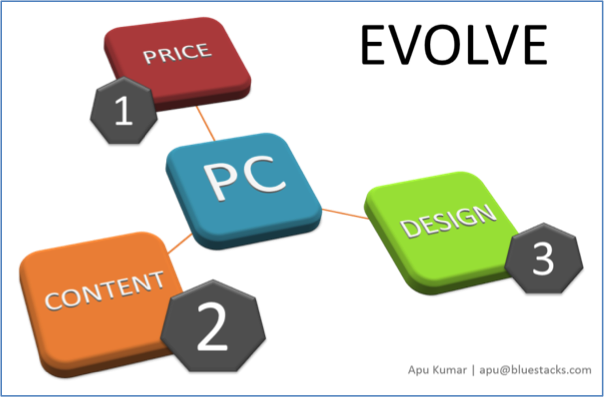Apu Kumar has held senior leadership roles at iconic technology brands as well as early stage start-ups, Hewlett-Packard, Phoenix Technologies, CNET.com, mySimon and is currently the SVP, Chief Deal Hacker at BlueStacks – GamePop. This is part 1 of a 2 part series from Apu on the PC industry.
Evolution
“We are the facilitators of our own creative evolution.”

The PC needs to evolve along 3 vectors – Price, Content and Design.
Price is a very sensitive issue and affects the entire supply chain, from the chipset manufacturer, to the component suppliers and the branding companies. Price varies by market segment and by geography. The optimum pricing strategies involve many considerations that are best left for another write-up.
Content is directly proportional to the size of the installed base and the core capabilities of the platform. The PC ecosystem is acutely aware of the need for more content and apps. From the content standpoint, the PC OEMs have primarily gone down two paths to bring apps and games from Android over to the Windows PC:
(1) Android + Windows dual boot
(2) Android embedded in Windows
Dual Boot is an archaic solution with two operating systems on the same PC. End users can select the OS to boot into when they turn on the PC. To switch to the other OS, users would need to reboot the PC and wait fiddling till the device starts up again. This is a tedious process, a jarring experience and a test of patience. To make things worse, dual boot creates 3 distinct personalities on the PC, (i) the classic Windows Desktop, (ii) the Windows Modern UI, and (iii) the classic Android Home screen. The resulting experience leaves end users puzzled with questions like “Where are my apps? Will the apps installed in Android also show up on the Windows Desktop? Will I see Modern tiles for my Android apps? If I connect to the Internet on my Windows Desktop, will my Android apps also pick up my Internet settings? Can I share my files and photos between Android and Windows?” Fundamental doubts like these have led to the demise of dual boot, and rightly so.

Disruptive start-ups like BlueStacks have put on their thinking caps to embed Android in Windows by using a concoction of new and unique technologies including virtualization, binary translation and graphics acceleration. End users are blissfully oblivious to the complexity of the underlying technologies as they enjoy Android and Windows side-by-side or simultaneously on the same PC. Users can freely create app shortcuts and modern tiles in Windows 8 for Android apps. But the core system settings like Wireless, Internet, Display, Printers are only accessible and configurable through Windows. Sensors like cameras, accelerometers, gyros are detected and enabled automatically. Games and apps can run windowed or full screen. Touch screens and touch pads are supported, as are smart key mappings and keyboard shortcuts. CES 2014 validated this approach with many of the leading PC brands and x86 chipset vendors launching PC designs with Android embedded in Windows.
 Good design is paramount to creating a successful product. Design-centric thinking has molded phenomenal products and great companies. Over the past years, PC design has progressed toward convertible form factors, also known as hybrid PCs or two-in-one PCs. Convertibles are an attempt to bring the goodness of mobile to the traditional laptop. By introducing touch screens and sensors, the ecosystem is hoping that consumers will see more value in the PC.
Good design is paramount to creating a successful product. Design-centric thinking has molded phenomenal products and great companies. Over the past years, PC design has progressed toward convertible form factors, also known as hybrid PCs or two-in-one PCs. Convertibles are an attempt to bring the goodness of mobile to the traditional laptop. By introducing touch screens and sensors, the ecosystem is hoping that consumers will see more value in the PC.
At CES 2014, PC brands justifiably paraded their convertibles with the glitz and glamor of an international auto show. The line-up contained a mix of impressive form factors and exotic designs. Some OEMs chose to detach the display from the keyboard of a traditional clamshell laptop PC to provide a tablet-like experience. Re-attaching the display to the keyboard enabled the classic laptop experience. Others OEMs chose to research, design and invest in fancy hinges to swivel, snap or contort the display to convert the PC turned into a tablet like magic.
Investing in design always pays rich rewards. It is refreshing to see the effort and focus on industrial design from the PC ecosystem. Convertible PCs are off to the races and the best designs will emerge victorious.
Resurrection
“If you can’t beat them right away, join them while you regroup and refocus.”
It used to be that the PC was the go-to device for all my computing needs. Now, I am tethered to my Android phone at all times as my main device for communication, social media, music and gaming. When I lean back, I put aside my phone and pick up my iPad, my preferred device for browsing, reading and watching movies. My phone and tablet also allow me to be creative and productive with a rich selection of apps for email, spreadsheets, document creation, sketching, ideation, 3D design, animation, project management and sales enablement. I can go so far as to dock my iPad to my Zagg Folio and viola, I have a functioning clamshell laptop – well almost.
Principal analyst at Creative Strategies, Tim Bajarin, is spot on in saying, “PCs continue to play a role in many people’s lives, but they are not as central as they once were. Tablets and smartphones have encroached on their place.” We are aware that the PC offers questionable value relative to mobile devices. This is in the matter of design, software, apps, services, simplicity and ease of use. Consumers are unwilling to overlook these glaring problems. Like analystß Ross Rubin wrote “it seems that anything that whiffs of the traditional PC has all the market appeal of a month-old banana”. The PC needs to wow consumers. Every PC needs a touch screen and a physical keyboard. Until such time that voice can be accurately interpreted, keystrokes will continue to be the input mechanism of choice. The classic hinge that connects the touch screen to the keyboard needs to be replaced with new connectors and hinges, both physical and wireless. The conventional “clamshell” form factor needs to transform into an origami of designs that unfold new modes of usage. Brands like Lenovo, Asus, Acer and Samsung have been creative in their industrial design with their new line of “Convertible PC” products. But that’s not enough; there needs to be a more concerted effort to innovate with a fierce sense of urgency. The PC needs to rip through its constrained design and race ahead to a new existence.
The PC can morph into a more relevant device, simple, useful and elegant. This will take a herculean effort on part of the PC manufacturers to innovate with new hybrid designs; they must be thinner and lighter and at lower price points. And then there’s software. Everyone agrees that the Windows PC needs apps by the hundreds of thousands to give it a fighting chance against Android and iOS. Microsoft will need to do its part in simplifying the new bipolar Windows OS and make it less power hungry. Startups like BlueStacks will need to work their magic to bring the full gamut of mobile apps, games and cloud services to the PC.
The PC industry needs to do all this and more and execute at lightning speed since their very existence is at stake. While they work to fix the bigger problems, it would behoove the PC industry to also find creative ways to connect and bridge the PC with the dominant mobile devices of today, namely Android smartphones and iPhones, with the goal to sync, extend and leverage the great content, apps, games and services from mobile devices and bring those to the PC. In short, what is need is total metamorphosis.
Empires rise and fall. From the ashes of fallen empires have risen new and more resilient worlds, with smarter and wiser constituents. The PC could face its destiny head on, or just lie down and be condemned to obscurity. The future of the PC hinges on this.

